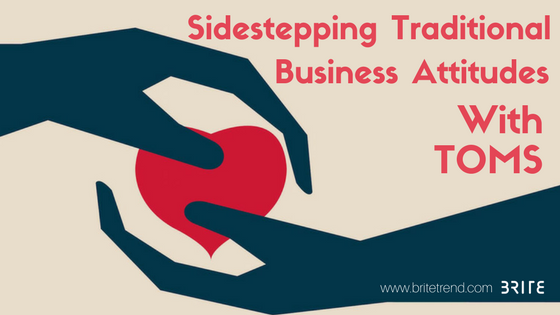When I was living in Canada some years ago I discovered a brand that was totally unknown in Italy where I’m from. Even if the temperature outside was -20 degrees Celsius, almost everybody at the yoga center I used to go to was wearing these nice TOMS cotton shoes. As a woman who loves fashion and environmentally conscious brands, I had to buy a pair as soon as possible, and when I did, I discovered the story behind TOMS. Some years have gone by since my first pair of TOMS and nowadays the company and its brand have become a global success. However, I’m sure that some of you still don’t know about TOMS, what they produce and the cause they aim to support. That’s why I decided to share this inspirational story with you. It’s more than just a story of one business owner’s dedication to his idea; it’s also about the ways in which companies can contribute to building better communities (and thrive!) by challenging traditional business models.
The story of TOMS shoes is one of hard work, a fearless entrepreneurial spirit and a positive global movement. TOMS is a fashion brand with an inner scope, supporting communities in need through the sales of its products, and engaging customers by creating awareness of the needs of others. Blake Mycoskie is the founder and Chief Shoe Giver of TOMS, as well as the mastermind behind The One-for-One business model that has powered the success of his company. One-for-One means that for every product they sell, which can be shoes, eyeglasses, bags or clothing apparel, the company gives away a similar item or supports an activity aimed at a person/community in need. Since 2006, TOMS has given away more than 35 million pairs of shoes in 60 countries. The one-for-one business model has catapulted to prominence since TOMS adopted it. Scores of similar businesses selling a wide range of products have followed suit. Warby Parker sells and distributes eyeglasses; Roma Boots sells and gives away boots; Nouri Bar donates a meal for a hungry child for every nutritional bar it sells; Sir Richard’s sells and donates condoms, and so on.
Despite having no marketing budget, Mycoskie took TOMS from his apartment in Los Angeles to a multi-million dollar company using the power of word of mouth. Curious, right? Let’s try to understand the secret to his success.
A Strong Entrepreneurial Spirit
Mycoskie has been operating businesses since the age of 19, starting with a college laundry service, which he later sold before moving onto other projects, including a billboard company, a reality TV channel and an online driver training website. He had a passion for running businesses in new areas and learning from each new experience that comes with his endeavors. At the beginning of his career, he didn’t have a core driver, but a strong entrepreneurial spirit.
As we all know, in business just like in love, a single event can change your entire life. This happened to Mycoskie in 2006, when he took some time off from his business ventures and went to Argentina to get lost in the local culture. While there, Mycoskie met an American woman volunteering for a shoe drive that was providing shoes to children in need. Captivated by what she was doing, he decided to accompany her around the country and help out. After witnessing first-hand these poor barefoot children, who he always knew existed in the back of his mind, Mycoskie felt a responsibility to help them with this basic necessity most people in developed countries often take for granted.
The Idea
With this new spark, Mycoskie's first thought was to set up a charity based around providing shoes to children in need. But after contemplating this idea further, he realized that the occasional shoe donation from strangers might dry up. He needed to come up with something that guaranteed a constant flow of shoes without relying solely on people’s goodwill. This is when he came up with the idea to start a shoe company that would donate a pair of shoes to a child in need for each pair it sold to the public. With this vision in mind, he set out to get his "Shoes for a better tomorrow" manufactured in Argentina, and decided to name his company "Tomorrow". It wasn’t until designing the tag to put on the shoes that he realized the word "Tomorrow" was too long, and decided to shorten the name to "TOMS".
As is often the case with startups, Mycoskie relied on friends and family to buy his first few pairs of shoes. Everybody soon fell in love with the story behind the shoes and the fact that they provided an easy way to give back to the less fortunate. It was evident since the beginning that from a marketing standpoint, the model was a winner. Research demonstrates that people are most motivated to help when they feel a connection with whom they are helping and It is easier to connect to a person than to an abstract action. So if a company is giving 10% for research, it’s hard to feel passionate about that. But if you are putting glasses on a poor child’s face, there is a very direct connection. From a psychological standpoint, it’s a smart strategy to connect one donor to one recipient.
The Growth of the Business
As a matter of fact, after receiving its first large order from American Rag, a retail store that specializes in unique and exclusive merchandise. TOMS began to increase in popularity throughout California by word of mouth. One day, a lady walked into American Rag to have a look at these shoes that her friend had told her about. The lady asked the shop owner about who was behind the shoes and where they came from. Falling in love with the story, she contacted Mycoskie for an interview with the newspaper she worked for. This newspaper was the LA Times, and following the publication of the interview, 2,200 pairs of shoes were ordered from the TOMS website. This surge in sales put pressure on the company, as Mycoskie only had 80 pairs of shoes in stock. A small army of interns had to be hired just to email and call customers informing them their purchases may take a few months rather than the four to five weeks advertised on the website. Three days later, Mycoskie jumped on a plane to Argentina to accelerate the production of shoes. The Argentinian shoemaker Mycoskie had been working with employed the help of other locals to speed up production in his garage workshop, and together they managed to start making up to 900 pairs of shoes a week.
After the small buzz on the West Coast of the United States the story of this selfless entrepreneur was soon picked up by the renowned fashion magazine Vogue. This unexpected publicity saw the sales of TOMS go from trendy LA stores to national retail giants such as Urban Outfitters and Nordstrom. In addition, many celebrities like Toby Maguire and Scarlett Johansson were photographed wearing TOMS. Since then, a simple idea to do good for others became a global movement inspiring many other businesses and having instant appeal among consumers looking for something more behind a product, like what the brand represents for them, society and the environment. The one-for-one business model is a sign that these companies value making a difference in society and customers choose them because of that.
TOMS Today
Since its early years, TOMS has expanded its product portfolio to include coffee beans, coffee shops, eyewear and bags, to name but a few. The social enterprise has directly impacted over 51 million people by giving them new shoes, restored vision and access to clean drinking water and safe births. All this while generating significant revenue, which in the company’s 2016 fiscal year was estimated to be around $392 million.
The one-for-one business model has also evolved. The company has responded to critics who connect it to the risks related to donating to poor communities versus the benefits of empowering people to build a better future through education and job opportunities. The major changes in the one-for-one business model are:
Shoes are produced in the countries where they are donated to create new job opportunities and to customize the shoes according to local needs (terrains and seasons) and traditions;
TOMS are always given to children through humanitarian organizations who incorporate shoes into their community development programs;
The one-for-one business model has shaped TOMS and is a defining factor for the company's success while inspiring many other entrepreneurs to focus on the ways in which their businesses can have a positive impact on the lives of others. What started as a company has now become a movement, that despite criticism about its true benefits, is driving positive change in the world.
The story of TOMS goes beyond the typical successful startup narrative and reflects the fact that both businesses and consumers can be more human. Attaining business objectives and contributing to the improvement of people’s lives are not mutually exclusive. As the TOMS story illustrates, these things can go hand-in-hand, and create a situation where the growth of a business can contribute to improving the well-being of communities and vice versa.
Chiara Caligara with Aidan McGrath and Bradley Castelli
Chiara Caligara
Managing Partner at Brite
Aidan Mc Grath
Digital Specialist at Brite
Bradley Castelli
Editor and Copywriter






